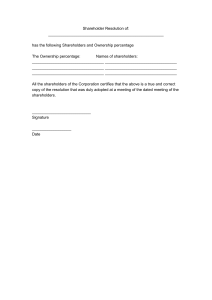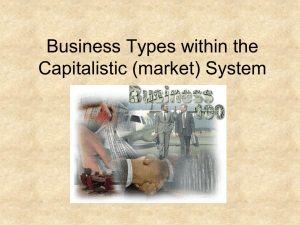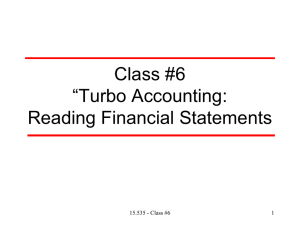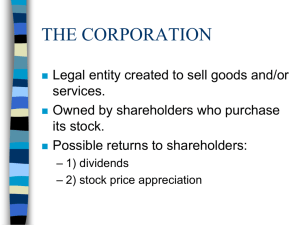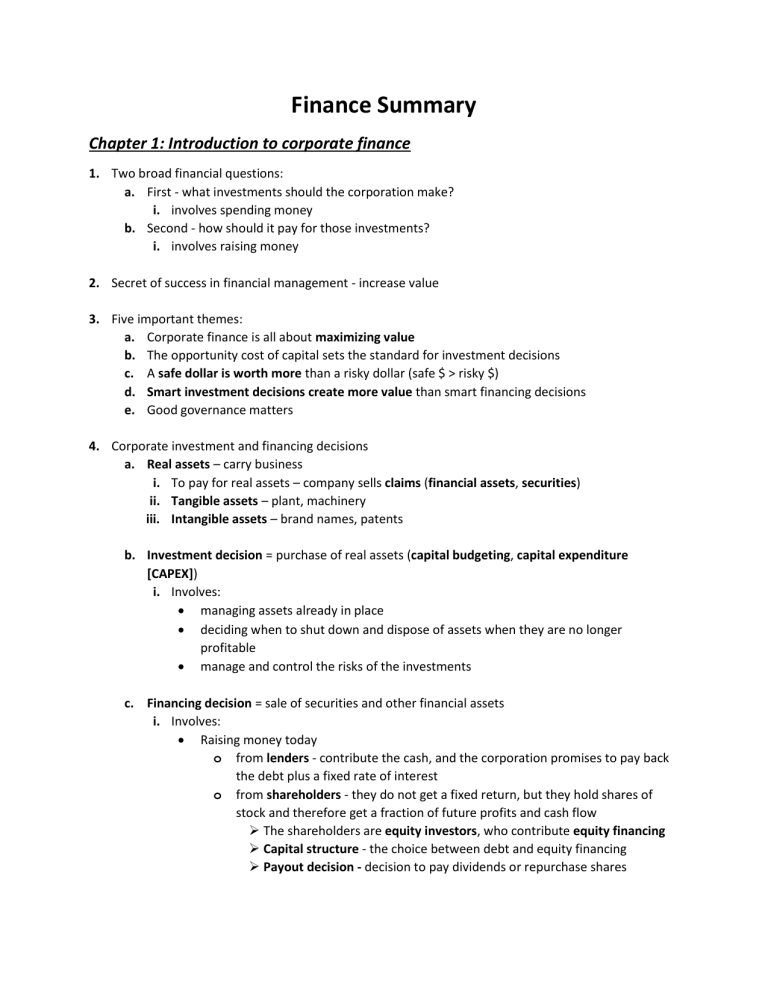
Finance Summary Chapter 1: Introduction to corporate finance 1. Two broad financial questions: a. First - what investments should the corporation make? i. involves spending money b. Second - how should it pay for those investments? i. involves raising money 2. Secret of success in financial management - increase value 3. Five important themes: a. Corporate finance is all about maximizing value b. The opportunity cost of capital sets the standard for investment decisions c. A safe dollar is worth more than a risky dollar (safe $ > risky $) d. Smart investment decisions create more value than smart financing decisions e. Good governance matters 4. Corporate investment and financing decisions a. Real assets – carry business i. To pay for real assets – company sells claims (financial assets, securities) ii. Tangible assets – plant, machinery iii. Intangible assets – brand names, patents b. Investment decision = purchase of real assets (capital budgeting, capital expenditure [CAPEX]) i. Involves: managing assets already in place deciding when to shut down and dispose of assets when they are no longer profitable manage and control the risks of the investments c. Financing decision = sale of securities and other financial assets i. Involves: Raising money today o from lenders - contribute the cash, and the corporation promises to pay back the debt plus a fixed rate of interest o from shareholders - they do not get a fixed return, but they hold shares of stock and therefore get a fraction of future profits and cash flow The shareholders are equity investors, who contribute equity financing Capital structure - the choice between debt and equity financing Payout decision - decision to pay dividends or repurchase shares meeting its obligations to banks, bondholders, and stockholders that have contributed financing in the past d. examples 5. An investment could be a smashing success or a dismal failure – cash returns are not guaranteed 6. Corporation – a legal person that is owned by its shareholders a. the corporation can make contracts, carry on a business, borrow or lend money, and sue or be sued b. a corporation can make a takeover bid for another and then merge the two businesses c. Corporations pay taxes d. Corporations can’t vote e. Corporations – based on articles of incorporation (set out the purpose of the business and how it is to be governed and operated) i. articles of incorporation - specify the composition and role of the board of directors (choose and advise top management, sign off on important corporate actions, such as mergers and the payment of dividends to shareholders) directors - elected by the shareholders (have limited liability - that they cannot be held personally responsible for the corporation’s debts) 7. Role of the financial manager 8. Financial goal of the corporation - shareholders want managers to maximize market value a. Stockholders want three things: i. To be as rich as possible - to maximize their current wealth ii. To transform that wealth into the most desirable time pattern of consumption either by borrowing to spend now or investing to spend later iii. To manage the risk characteristics of that consumption plan iv. Hurdle rate/cost of capital – minimum rate of return 9. Agency problems and corporate governance a. separation of ownership and control in public corporations – owners/shareholders cannot control what the managers do, except indirectly through the board of directors b. agency problems - arise when agents (managers) work for principals (shareholders) i. agency cost - incurred when: managers do not attempt to maximize firm value shareholders incur costs to monitor the managers and constrain their actions 10. Preview of coming attractions a. How do I calculate the rate of return? - from the cash inflows and outflows generated by the investment project b. Is a higher rate of return on investment always better? - Not always, for two reasons: i. First - lower-but-safer return can be better than a higher-but-riskier return ii. Second - an investment with a higher percentage return can generate less value than a lower-return investment that is larger or lasts longer. c. What determines value in financial markets? - Sometimes the financial manager is lucky, and may find an almost identical asset whose value is already known. For most major financial decisions, the manager needs some fundamental principles to help him to determine value. d. What are the cash flows? - the sum of all cash inflows and outflows caused by the decision to invest i. cash flows are calculated after corporate taxes are paid. They are the free cash flows that can be paid out to shareholders or reinvested on their behalf. e. How does the financial manager judge whether cash-flow forecasts are realistic? “Prediction is difficult, especially if it’s about the future.” (- Niels Bohr) But good financial managers take care to assemble relevant information and to purge forecasts of bias and thoughtless optimism. f. How do we measure risk? - We look to the risks born by shareholders, recognizing that investors can dilute or eliminate some risks by holding diversified portfolios g. How does risk affect the opportunity cost of capital? - The most widely used theory is the Capital Asset Pricing Model h. Where does financing come from? - from borrowing or from cash invested or reinvested by stockholders i. Debt or equity? Does it matter? - the choice between debt and equity does matter for many possible reasons - taxes, the risks of bankruptcy, information differences, and incentives Q&A Chapter 1 1. Investment and financing decisions Companies usually buy (real) assets. These include both tangible assets such as (executive airplanes) and intangible assets such as (brand names). To pay for these assets, they sell (financial) assets such as (bonds). The decision about which assets to buy is usually termed the (investment) or (, capital budgeting) decision. The decision about how to raise the money is usually termed the (financing) decision. 2. Investment and financing decisions Which of the following are real assets, and which are financial? a. A share of stock b. A personal IOU c. A trademark d. A factory e. Undeveloped land f. The balance in the firm’s checking account g. An experienced and hardworking sales force h. A corporate bond 3. Investment and financing decisions Vocabulary test. Explain the differences between: a. Real and financial assets i. Real assets are value-generating physical assets that a business and/or investor owns (land, buildings, ships, other infrastructure or commodities). A real asset has intrinsic value in and of itself does not rely on monetization and/or exchange in order to provide value for its owner. ii. Financial assets are highly liquid assets that are either cash or can quickly be converted into cash (stocks, bonds). A financial asset has a known monetary value that can readily be realized. However, it in and of itself lacks any intrinsic value. b. Capital budgeting and financing decisions i. Capital budgeting (investment decision) is the decision to purchase real assets. It involves managing assets that are already in place and deciding when to shut down and dispose of an asset when it is no longer profitable. ii. Financial decision is the decision to sell securities/other financial assets. It involves raising cash today, as well as meeting the corporation’s obligations to banks, bondholders, stockholders that have contributed financially in the past. c. Closely held and public corporations i. Closely held corporations – (in the beginning) the company is held by a small group of investors, the shares are not publically traded ii. Public corporations – (when the company grows) new shares are issued to raise additional capital, the shares are traded in public markets d. Limited and unlimited liability i. Limited liability – shareholders can NOT be held personally responsible for the corporation’s debts ii. Unlimited liability - If the business runs into difficulties, each partner can be held responsible for all the business’s debts 4. Corporations Which of the following statements always apply to corporations? a. Unlimited liability b. Limited life c. Ownership can be transferred without affecting operations d. Managers can be fired with no effect on ownership 5. Separation of ownership In most large corporations, ownership and management are separated. What are the main implications of this separation? A large public corporation may have hundreds of thousands of shareholders, who own the business but cannot possibly manage or control it directly. This separation of ownership and control gives corporations permanence. Even if managers quit or are dismissed and replaced, the corporation survives. Downside, separation of ownership and control can open the door for managers and directors to act in their own interests rather than in the stockholders’ interest. Because the corporation is a separate legal entity, it is taxed separately. So corporations pay tax on their profits, and shareholders are taxed again when they receive dividends from the company or sell their shares at a profit. 6. Corporate goals We can imagine the financial manager doing several things on behalf of the firm’s stockholders. For example, the manager might: a. Make shareholders as wealthy as possible by investing in real assets b. Modify the firm’s investment plan to help shareholders achieve a particular time pattern of consumption c. Choose high- or low-risk assets to match shareholders’ risk preferences d. Help balance shareholders’ checkbooks But in well-functioning capital markets, shareholders will vote for only one of these goals. Which one? Why? “Make shareholders as wealthy as possible by investing in real assets” because stockholders prefer to be rich rather than poor. This increased wealth can then be put to whatever purposes the shareholders want.

